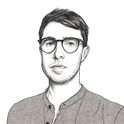Our collective experience of the past few years seems almost purpose-built for an artist and photographer like Andreas Gursky. His inclination towards producing images of empty apartment blocks, deserted streets and other unpopulated urban areas (or giant landscapes where people are reduced to mere specks), means the German artist has long recorded the “look” of modern-day isolation. Until now, the lengths he would go to capture these disquieting spaces made his images feel fake or exaggerated. Two years into a pandemic, they look almost too familiar.
None of the new photographic works by Gursky, now on display at White Cube until 26th June, are older than four years old; most were taken during the worst lockdowns between 2020 and 2021. The mix is more eclectic than you might expect: not just Gursky’s typical large-scale prints of empty buildings and construction sites, but also runway models, German politicians, pigs and even smaller images of domestic settings, such as of a mother holding her child.
All of Gursky’s photographs here, regardless of subject, exhibit their signature unreal quality: he does not so much take photographs as “make” them. You can never shake the feeling that what you are seeing is something meticulously constructed, whether it is a mossy riverbank, a white cuboid factory or a crowd of ravers. Everything is straight edged. Everything is precisely composed. Everything is flat and shadowless. If you could hear his images, they would make no noise.
Some of the pieces here are “revisits” of previous works—including a recapture of the same spot where Gursky took Rhein II (1999), which is primarily known today by its murky accolade as the world’s most expensive photograph (a print sold for £2.7m at auction in 2011). In Rhein III, we are once again by the banks of the Rhine some two decades later in 2018. The grass is scorched yellow from heat, and beyond it sits the river—grey, glacial and unmoving. Too often in art-world speak “revisiting” is a euphemism for when an artist has begun their descent into self-parody, and it’s hard not to feel like that is what is happening here. The climate change message in Rhein III is too obvious and not particularly interesting. Maybe the only reason Gursky revisited Rhein II was to try and reclaim it from the market forces that have since defined it.

Some of Gursky’s smaller images also leave much to be desired. One diptych, Königsbergerstrasse (2020), shows a woman with a box on her head in the middle of a tense building-block game. In the first image, the woman is primed to blindly place the last block on the top of a tower—in the second she is in the act of doing it, leaving us unsure whether she has succeeded without knocking it over. Taken during lockdown, the image is almost too comical for its own metaphor of precarity. There is a certain irony that just when isolation became so real and for so many, Gursky became unable to capture it with his typical force.
None of this is to say that Gursky has lost his eye, only that it comes out best when he maintains a degree of distance from his subject matter and withholds from easy messages—like Kreuzfahrt (Cruise), also from 2020. Here we are met with the side-on view of a luxury cruise ship. As the details stack up a unique story emerges. Blue tarpaulin strewn about suggests the ship is under the last stages of construction. Among its huge grid of windows we find signs of life everywhere, like curtains half drawn and doors left open—yet where are the people? It’s as if everyone has gone off to do something more interesting. Then in one corner we find it: the black silhouette of a woman’s head through a yellow-lit window. What is she doing here all by herself?

When people come into Gursky’s imagery, they always play their strongest part when they are small and almost subsumed by their environment. In Eislaufer (ice skater) from 2021, people are shown dotted around a snow-covered meadow by a frozen Rhine near Düsseldorf. It’s busy by the river, as many open communal spaces like this would have been during lockdown. The comparisons to Bruegel are explicit: in the distance we see ice-skaters, just as in The Hunters in the Snow (1563). But the people in this image have as much in common with the CGI imagery of building development billboards as with the Northern Renaissance. Close up, they look like shadowless cut-outs, almost placed on the landscape rather than a part of it. The image has been digitally altered, meaning the scene is artificial: not all these people would have been present at the same time. Yet if their positioning within the landscape has been carefully plotted by Gursky, it does not strike us as unusual in and of itself: they could simply be maintaining social distancing. The overall impression is something both relatable and “true,” but with that same lingering sense of unreality. Gursky has made it feel at once familiar and fake.
Gursky says that “the imperative to find images leads me to my subjects, not the other way round.” But it seems that the more that real life has caught up with his imagery, the more this “imperative to find images” occasionally slips to become the imperative to make sense of them—and where the temptation to fall back on easy truisms lies. So long as he can avoid that temptation, he remains one of the keenest observers of the look—and the feel—of the disquiet of modern life.
Andreas Gursky is on display at White Cube Bermondsey from 29th April to 26th June














